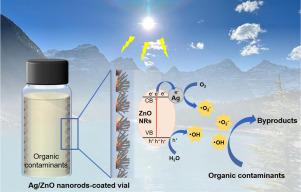在玻璃基底上固定 Ag/ZnO 纳米棒的新方法:在太阳光驱动的水中微污染物降解中的应用
IF 11.4
1区 环境科学与生态学
Q1 ENGINEERING, ENVIRONMENTAL
引用次数: 0
摘要
将光催化剂用于水处理的主要挑战之一是复杂的分离和回收过程。在这项研究中,我们利用溶剂交换工艺(SEP)和水热煅烧技术开发了固定在玻璃瓶上的高稳定性多孔氧化锌纳米棒(ZnO NRs)。对油酸浓度和水热生长时间等关键参数进行了优化,以最大限度地增加活性表面积,从而显著提高光降解性能。在最佳条件下,ZnO NRs 涂层小瓶在模拟太阳照射 10 小时后,磺胺甲噁唑(SMX)的降解率接近 100%。在 ZnO NRs(Ag/ZnO NRs)表面沉积银纳米粒子可进一步提高性能,将降解时间缩短至 4 小时,并提高光催化剂的稳定性。经过优化的 Ag/ZnO NRs 涂层小瓶(Ag 前体浓度为 0.05 M)在多个重复使用周期内对环境相关浓度的八种有机微污染物具有很高的降解率(>>99%),且金属浸出极少。这项研究提出了一种在玻璃基底上固定光催化剂的创新可调方法,它具有高表面积、出色的光催化活性和机械性能,非常适合水处理应用。本文章由计算机程序翻译,如有差异,请以英文原文为准。


A novel approach for immobilizing Ag/ZnO nanorods on a glass substrate: Application in solar light-driven degradation of micropollutants in water
One of the main challenges in applying photocatalysts for water treatment is the complex separation and recycling process. In this study, we developed highly stable, porous zinc oxide nanorods (ZnO NRs) immobilized on glass vials using a solvent exchange process (SEP) and hydrothermal calcination. Key parameters, including oleic acid concentration and hydrothermal growth time, were optimized to maximize the active surface area, significantly enhancing photodegradation performance. Under the best conditions, ZnO NRs-coated vials achieved nearly 100% degradation of sulfamethoxazole (SMX) in 10 h of simulated solar irradiation. Depositing silver nanoparticles on the surface of ZnO NRs (Ag/ZnO NRs) further improved performance, reducing degradation time to 4 h and increasing photocatalyst stability. The Ag/ZnO NRs-coated vials, optimized with an Ag precursor concentration of 0.05 M, also demonstrated high degradation rates (99%) for eight organic micropollutants at environmentally relevant concentrations over multiple reuse cycles and with minimal metal leaching. This study presents an innovative, tunable method for immobilizing photocatalysts on glass substrates, offering high surface area, excellent photocatalytic activity, and mechanical properties, making it highly suitable for water treatment applications.
求助全文
通过发布文献求助,成功后即可免费获取论文全文。
去求助
来源期刊

Water Research
环境科学-工程:环境
CiteScore
20.80
自引率
9.40%
发文量
1307
审稿时长
38 days
期刊介绍:
Water Research, along with its open access companion journal Water Research X, serves as a platform for publishing original research papers covering various aspects of the science and technology related to the anthropogenic water cycle, water quality, and its management worldwide. The audience targeted by the journal comprises biologists, chemical engineers, chemists, civil engineers, environmental engineers, limnologists, and microbiologists. The scope of the journal include:
•Treatment processes for water and wastewaters (municipal, agricultural, industrial, and on-site treatment), including resource recovery and residuals management;
•Urban hydrology including sewer systems, stormwater management, and green infrastructure;
•Drinking water treatment and distribution;
•Potable and non-potable water reuse;
•Sanitation, public health, and risk assessment;
•Anaerobic digestion, solid and hazardous waste management, including source characterization and the effects and control of leachates and gaseous emissions;
•Contaminants (chemical, microbial, anthropogenic particles such as nanoparticles or microplastics) and related water quality sensing, monitoring, fate, and assessment;
•Anthropogenic impacts on inland, tidal, coastal and urban waters, focusing on surface and ground waters, and point and non-point sources of pollution;
•Environmental restoration, linked to surface water, groundwater and groundwater remediation;
•Analysis of the interfaces between sediments and water, and between water and atmosphere, focusing specifically on anthropogenic impacts;
•Mathematical modelling, systems analysis, machine learning, and beneficial use of big data related to the anthropogenic water cycle;
•Socio-economic, policy, and regulations studies.
 求助内容:
求助内容: 应助结果提醒方式:
应助结果提醒方式:


